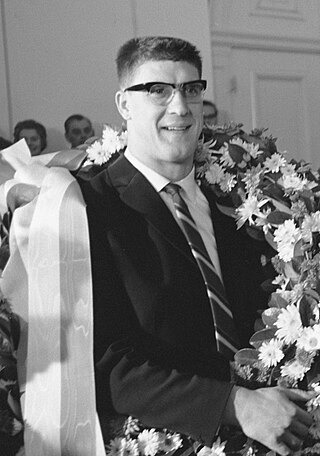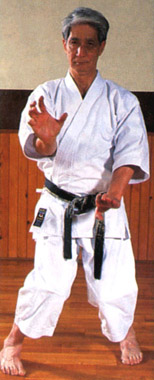
Antonius Johannes Geesink was a Dutch 10th dan judoka. He was the first non-Japanese judoka to win gold at the World Judo Championships, a feat he accomplished in 1961 and 1965. He was also an Olympic Champion, having won gold at the 1964 Summer Olympics in Japan, and won a record 21 European Judo Championships during his career.

Keiko Fukuda was a Japanese-American martial artist. She was the highest-ranked female judoka in history, holding the rank of 9th dan from the Kodokan (2006), and 10th dan from USA Judo and from the United States Judo Federation (USJF), and was the last surviving student of Kanō Jigorō, founder of judo. She was a renowned pioneer of women's judo, and in 1972 together with her senpai Masako Noritomi (1913–1982) was one of the first two women promoted to 6th dan. In 2006, the Kodokan promoted Fukuda to 9th dan, making her the first woman to hold this rank from any recognized judo organization. She is also the first and, so far, only woman to have been promoted to 10th dan in judo, which occurred in 2011. After completing her formal education in Japan, Fukuda visited the United States to teach in the 1950s and 1960s, and eventually settled there. She continued to teach her art in the San Francisco Bay Area until her death in 2013.

Kyū is a Japanese term used in modern martial arts as well as in tea ceremony, flower arranging, Go, shogi, academic tests and other similar activities to designate various grades, levels or degrees of proficiency or experience. In Mandarin Chinese, the same character 級 is pronounced jí, and the term is used for academic tests. In Korea, the term geup is used. In Vietnamese martial arts, it is known as cấp (khớp).

The Budokwai (The Way of Knighthood Society) (武道会, Budōkai, Society of the Martial Way) in London is the oldest Japanese martial arts club in Europe. It was founded in 1918 by Gunji Koizumi and initially offered tuition in jujutsu, kendo, and other Japanese martial arts. It was the first judo club in Europe.

The Kodokan Judo Institute (公益財団法人講道館), or Kōdōkan (講道館), is the headquarters of the worldwide judo community. The kōdōkan was founded in 1882 by Kanō Jigorō, the founder of judo, and is now an eight-story building in Tokyo.

Hidetaka Nishiyama was a prominent Japanese master of Shotokan karate. He was an internationally recognized instructor, author, and administrator, and helped to establish the Japan Karate Association. Nishiyama was one of the last surviving students of Gichin Funakoshi, founder of Shotokan karate. He was based in the United States of America from 1961 until his death in 2008, and was a pioneer of karate in that country. He had been posthumously awarded the rank of 10th dan in karate.
Philip Masato Takahashi was a judoka from Canada, who represented his native country at two consecutive Summer Olympics. He twice won a bronze medal at the Pan American Games during his career in the bantamweight division, in 1979 and 1983. His greatest achievement came as a bronze medal at the 1981 World Championships. In 1986, he won the bronze medal in the 60 kg weight category at the judo demonstration sport event as part of the 1986 Commonwealth Games.
Koji Sone was a Japanese judoka and world champion.

Yoshukai is a Japanese style of Karate–dō. Karate-do. Karate-do translates as "Way of the Empty Hand." The three kanji that make up the word Yoshukai literally translate as "Training Hall of Continued Improvement." However, the standardized English translation is "Striving for Excellence." Yoshukai Karate has been featured in Black Belt Magazine. Yoshukai karate is a separate Japanese style from Chito-ryu. Kata, kobudo, kumite, and all karate aspects are drawn from the Founder, Mamoru Yamamoto. Yoshukai is a newer derivative Japanese style.

Tomita Tsunejirō, born Yamada Tsunejirō, was the earliest disciple of judo. His name appears in the first line of the enrollment book of the Kōdōkan. Tomita, together with Saigō Shirō, became the first in the history of judo to be awarded the rank of Shodan by the founder of judo, Kanō Jigorō, who established the ranking system that is now commonly used in various martial arts around the world. Tomita was known as one of the "Four Kings" of Kōdōkan judo for his victorious efforts in competing against jujitsu schools. He was awarded 7th dan upon his death on January 13, 1937.
In judo, improvement and understanding of the art is denoted by a system of rankings split into kyū and dan grades. These are indicated with various systems of coloured belts, with the black belt indicating a practitioner who has attained a certain level of competence.

Shiro Saigo was one of the earliest disciples of Judo. Saigo, together with Tsunejiro Tomita, became first in history of judo to be awarded Shodan by the founder of judo Jigoro Kano, who established the kyu-dan ranking system. He was one of the Kōdōkan Shitennō or Four Guardians of the Kodokan along with Yoshitsugu Yamashita, Sakujiro Yokoyama, and Tsunejiro Tomita.

The Japanese martial art and combat sport judo has been practised in Canada for over a century. The first long-term judo dojo in Canada, Tai Iku Dojo, was established by a Japanese immigrant named Shigetaka "Steve" Sasaki in Vancouver in 1924. Sasaki and his students opened several branch schools in British Columbia and even trained RCMP officers until 1942, when Japanese Canadians were expelled from the Pacific coast and either interned or forced to move elsewhere in Canada due to fears that they were a threat to the country after Japan entered the Second World War. When the war was over, the government gave interned Japanese Canadians two options: resettle in Canada outside of the 'Japanese exclusion zone' or emigrate to Japan.
Hugh Raymond Takahashi is a wrestler, judoka, coach, lecturer, and author who represented Canada in wrestling at the 1976 and 1984 Summer Olympic Games, the 1982 and 1983 Wrestling World Championships, the 1978 and 1982 Commonwealth Games, and the 1983 Pan-American Games. Takahashi won gold in the Flyweight division at the Commonwealth Games, and placed fourth at his second Olympic Games. He holds 16 Canadian national wrestling titles and was inducted into the Canadian Wrestling Hall of Fame in 1991. He is also ranked san-dan in the Japanese martial art Judo, the son of noted Canadian judoka Masao Takahashi and June Takahashi, and the brother of fellow Olympian Phil Takahashi and Olympic coach Tina Takahashi.
Tina Takahashi is a Canadian judoka, coach and author. She won Canada's first gold medal at the World University Games in Judo in 1984 and coached Canada's first women's Judo Olympian Sandra Greaves in the 1988 Olympics in Seoul. Takahashi was the first Canadian woman to achieve the rank of roku-dan, and the first women's Sport Canada carded athlete.
Yoshio "John" Katsuta was a Japanese-Canadian judoka born in Okayama, Japan who founded Alberta's first Judo dojo in Raymond, Alberta in 1943, and was the first president of the Alberta Black Belt Association, founded in 1952. Katsuta was ranked roku-dan and was the recipient of many honours and awards for his service to the community and promotion of Judo in Canada. He received the Canadian Centennial Medal in 1967 and the 125th Anniversary of the Confederation of Canada Medal in 1992, was awarded the Hokkaido Cup from the Governor of Japan in 1987, and was posthumously recognized with an Alberta Centennial Salute to Sport and Recreation Award in 2005. Katsuta was also inducted into the Raymond Sports Hall of Fame in 1987 and the Alberta Sports Hall of Fame in 2008, made a lifetime member of Judo Canada in 1983, and inducted into its Hall of Fame in 1996.

Shigetaka "Steve" Sasaki was a Japanese and Canadian judoka who founded the first judo club in Canada and is considered the 'Father of Canadian Judo'. After establishing the Tai Iku Dojo in Vancouver in 1924, Sasaki and his students opened several branch schools in British Columbia and also trained RCMP officers until 1942, when Japanese Canadians were expelled from the Pacific coast and either interned or forced to move elsewhere in Canada due to fears that they were a threat to the country after Japan entered the Second World War. When the war was over, the government required interned Japanese Canadians to either resettle in Canada outside of British Columbia's 'Japanese exclusion zone' or emigrate to Japan.
The Japanese martial art and combat sport judo has been practised in the Canadian province of Ontario since 1942.
The Japanese martial art and combat sport judo has been practised in the Canadian province of Quebec since 1946.
The Japanese martial art and combat sport judo has been practised in the Canadian province of Manitoba since the 1940s.











